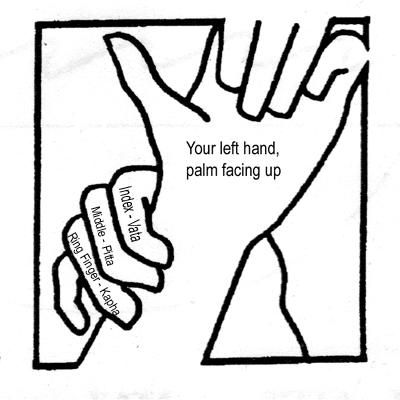To perform Ayurvedic self pulse diagnosis, feel your pulse with three fingers as shown in the images below. Men, use the fingers of your right hand to feel your left wrist. Women, switch hands and feel the pulse on your right wrist.
In the image below, the man's left wrist is placed in his right palm. He curls his right fingers up to touch the outer area of his left wrist. It is recommended that you first find the pulse with your ring finger, then the middle finger and finally the index finger. However, when you are first experimenting with this and you are not yet sure exactly where to touch your wrist, you can start locating your pulse with your index finger.
Your index finger will be just below the radial bone in your wrist. From this bone, if you move your finger toward your elbow about one finger width, you will be located over soft tissue where you can feel your pulse. Go ahead and try it.
Bob Zanotti, writing in "Swiss News" calls pulse diagnosis, "the centrepiece of a classic Ayurveda examination." He goes on to say, "Through a prolonged observation of the pulse (right wrist for men, left wrist for women), the condition of the vital organs as well as the general health of the patient can be determined with great accuracy. Even specific conditions and ailments can be detected. Pulse diagnosis also uncovers any deep stress - a key factor in psychosomatic illness, which according to the WHO, accounts for at least 80 percent of all illness in the West. But at the heart of this lengthy diagnostic process is the determination of one's [individual body type and current state of balance]"
Bob calls your individual body type your "Physical Personality." He says, "Ayurveda identifies three distinct elements/ humours or 'doshas' that are present in each and every body: 'Vata', 'Pitta' and 'Kapha' (pronounced kaffa). Each 'dosha' controls particular organs or bodily functions. Most of us have all three in our system, but in varying proportions. When our personal 'dosha balance' is correct, we enjoy good health, both physical and mental. But through stress, improper diet or other lifestyle factors, the 'doshas' sometimes fall out of balance. When that happens, we are open to illness and disease, including emotional and behavioural disturbances - also accelerated ageing."
The image below shows that each of the three fingers used to detect the pulse are associated with one of the doshas.
The qualities listed above in the top row in each column are the "home" qualities of the pulse for that dosha. In other words, one would expect to feel the pulse jumping like a frog with the middle finger because that is the normal quality of the Pitta pulse. Vata would normally feel like a Cobra (snake) and Kapha like a smooth swan.
Under different conditions, these qualities can leave their home location and appear at the home of one of the other doshas. For example, the frog quality can move from Pitta (the middle finger) to Vata (the index finger) at times.
When the qualities of the pulse are not at home, it can indicate an imbalance in one's health. However, with experience you will learn to feel changes in your pulse with the time of the day, upon eating, and even with changes in the outside weather. So it is normal to feel changes in the pulse and you do not need to become concerned immediately if your pulse qualities listed above are not at their home location.
To conclude this lesson one, I advise you to simply practice feeling your pulse with your three fingers as illustrated above. You do not need to understand all the details. Simply putting your attention on your pulse has a balancing effect on your physiology. Just take a quiet minute a few times a day to let your mind enjoy the feeling of your pulse. This procedure by itself, with no intellectual analysis of your doshas, will help balance your health.
More lessons about how to analyze your doshas will appear in future articles here at FitEyes.com. In particular, I will discuss how to use Ayurvedic self pulse diagnosis as part of your program to lower your intraocular pressure.
Here are two links I found today that briefly mention Ayurvedic pulse diagnosis.
http://www.dreddyclinic.com/ayurvedic/diagnose.htm
http://www.lifepositive.com/body/ayurveda/naram.asp
Here are a few more quotes from Bob Zanotti's article in "Swiss News":
The World's Oldest Medicine
Translated from the Sanskrit word 'Ayurveda', it literally means 'the science of living'. It's the oldest and most extensive holistic system for promoting and maintaining health, officially recognised by the World Health Organization. Ayurveda goes back a long way: at least 3,500 years - some experts say as far as 6,000 - making it the oldest documented form of medical practice. It was the inspiration for Chinese medicine and is also said to have greatly influenced early Greek medical philosophy.
Ayurveda teaches the uniqueness of every body, which is why a consultation with an Ayurvedic physician takes time (usually about three-quarters of an hour, and sometimes longer). Many questions are asked, and there is a careful examination of the skin, nails, hair, eyes and tongue - all barometers of one's constitution and state of health. As a rule, there are no blood or other body-fluid samples taken, and there is no laboratory testing, as is typical of Western medicine.
Read Bob's entire article here: http://www.alkalizeforhealth.net/Ltmhealth25.htm
- dave's blog
- Log in or register to post comments

